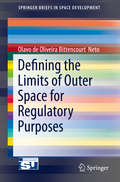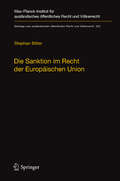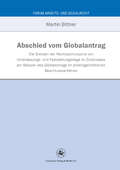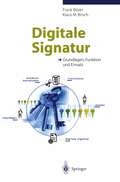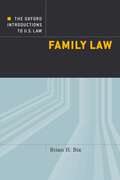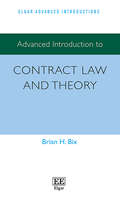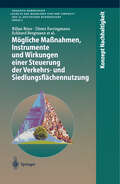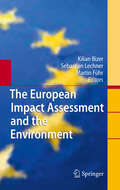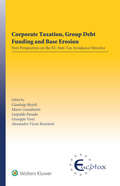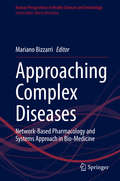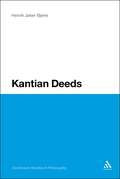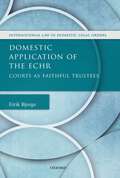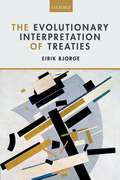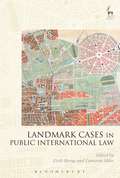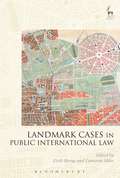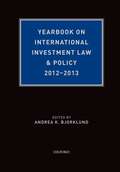- Table View
- List View
Defining the Limits of Outer Space for Regulatory Purposes (SpringerBriefs in Space Development)
by Olavo de Bittencourt NetoWith different countries ascribing to different theories of air space and outer space law, Dr. Bittencourt Neto proposes in this Brief a reassessment of the international law related to the extension of state territories vertically. Taking into consideration the vast number of proposals offered by scholars and diplomatic delegations on this subject matter, as well as the principles of comparative law, a compromise to allow for peaceful development is the only way forward. The author argues for setting the delimitation of the frontier between air space and outer space at 100 km above mean sea level through an international treaty. This would also regulate passage rights for space objects during launchings and reentries, as long as those space activities are peaceful, conducted in accordance with international law and respecting the sovereign interests of the territorial State. Continuing expansion of the commercial space industry and conflicting national laws require a stable and fair legal framework best adjudicated by the United Nations, instead of allowing a patchwork system to persist. The proper framework for developing such regulation is carefully discussed from all angles with a practical recommendation for policy-makers in the field.
Die Sanktion im Recht der Europäischen Union: Der Begriff und seine Funktion im europäischen Rechtsschutzsystem (Beiträge zum ausländischen öffentlichen Recht und Völkerrecht #222)
by Stephan BitterAusgehend von einer Analyse des europäischen Primär- und Sekundärrechts sowie der Rechtsprechung des Europäischen Gerichtshofs unternimmt der Autor den Versuch, einen einheitlichen Begriff der Sanktion für das Unionsrecht zu entwickeln. In der Begriffsbildung sieht er eine zentrale Aufgabe für das europäische Rechtsschutzsystem. Denn die Feststellung, dass in einer bestimmten Maßnahme eine Sanktion zu sehen ist, fungiert in der Rechtsprechung als Instrument, um den Anwendungsbereich der Verteidigungsrechte zu eröffnen.
Abschied vom Globalantrag: An den Grenzen der Rechtsschutzzone von Unterlassungs- und Feststellungsklage im Zivilprozess am Beispiel des Globalantrags im arbeitsgerichtlichen Beschlussverfahren (Forum Arbeits- und Sozialrecht #39)
by Martin BittnerIm Zivilprozess geht es den Parteien vielfach nicht nur um die gerichtliche Entscheidung des Einzelfalls. Von dem Urteil erhoffen sie sich auch eine verbindliche Orientierungshilfe für die Zukunft. Zu diesem Zweck wird ein „Globalantrag“ zum Gegenstand von Unterlassungs- und Feststellungsklagen gemacht. Die Gerichte werden auf diesem Wege um eine umfassende Rechtsauskunft gebeten. Wo hierbei die Grenze des Zulässigen verläuft, ist in Wissenschaft und Praxis noch nicht hinreichend geklärt. Der Verfasser leuchtet die Rechtsschutzzone von Unterlassungs- und Feststellungsklage im Zivilprozess am Beispiel des Globalantrags im arbeitsgerichtlichen Beschlussverfahren aus. Auf die kritische Analyse der Rechtsprechung zum Thema folgt der Vorschlag alternativer Vorgehensweisen, um das Begehren der Prozessparteien nach Rechtssicherheit über den konkreten Streitfall hinaus zu befriedigen.
Doing Things for Reasons
by Rudiger BittnerWhat exactly are the reasons we do things, and how are they related to the resulting actions? Bittner explores this question and proposes an answer: a reason is a response to that state of affairs. Elegantly written, this work is a substantial contribution to the fields of rationality, ethics, and action theory.
Good Things to Do: Practical Reason without Obligation
by Rüdiger BittnerRüdiger Bittner argues that the aim of thinking about what to do, of practical reason, is to find, not what we ought to do, but what it is good to do under the circumstances. Neither under prudence nor under morality are there things we ought to do. There is no warrant for the idea of our being required, by natural law or by our rationality, to do either what helps us attain our ends or what is right for moral reasons. While common moral understanding is committed to there being things we ought to do and to our being guilty and deserving blame if we fail to do them, we can lay aside these notions without loss, indeed with benefit. The volume also explains what it is for something to be good to do under the circumstances and argues for understanding practical reason in these terms. What is good to do we find by experience: what we go through teaches us what helps and what hinders, and helps us figure out what is prudentially useful and what is morally right to do-although ultimately this difference itself gives way, and morality turns out to be a part of prudence.
Good Things to Do: Practical Reason without Obligation
by Rüdiger BittnerRüdiger Bittner argues that the aim of thinking about what to do, of practical reason, is to find, not what we ought to do, but what it is good to do under the circumstances. Neither under prudence nor under morality are there things we ought to do. There is no warrant for the idea of our being required, by natural law or by our rationality, to do either what helps us attain our ends or what is right for moral reasons. While common moral understanding is committed to there being things we ought to do and to our being guilty and deserving blame if we fail to do them, we can lay aside these notions without loss, indeed with benefit. The volume also explains what it is for something to be good to do under the circumstances and argues for understanding practical reason in these terms. What is good to do we find by experience: what we go through teaches us what helps and what hinders, and helps us figure out what is prudentially useful and what is morally right to do-although ultimately this difference itself gives way, and morality turns out to be a part of prudence.
Digitale Signatur: Grundlagen, Funktion und Einsatz
by Frank Bitzer Klaus M. BrischDigitale Kommunikation dringt in immer mehr Bereiche privater und unternehmerischer Anwendungsfelder ein. Seit 1997 sind die gesetzlichen Rahmenbedingungen in Deutschland für rechtlich gesicherte Vorgänge im Internet geschaffen. Zentraler Bestandteil ist die digitale Signatur. Die Autoren erklären anschaulich und detailliert deren Konzept und Einsatzmöglichkeiten. Die Funktionen von Signatur, Trustcenter, Chipkarte und asymmetrischem Schlüsselverfahren werden dargestellt und durch zahlreiche Diagramme verdeutlicht. Die Informationen dienen als Entscheidungsgrundlage für den Einsatz der digitalen Signatur in Firmen, Institutionen und Behörden. Die Anwendungsbeispiele beziehen sich auf Business-to-Business- und Business-to-Customer-Beziehungen in Intranet und Internet. Das Werk wendet sich vor allem an Produzenten digitaler Medien sowie Entscheider in Wirtschaft und Verwaltung.
The Oxford Introductions to U.S. Law: Family Law (Oxford Introductions to U.S. Law)
by Brian BixA book about family law is necessarily a book both about family life and the role law can and should take in regulating family life. Individually and together, these are vast topics. American family law is ever-changing and affects every facet of our lives. The Oxford Introductions to U.S. Law: Family Law provides a critical introduction to the enduring topics in the field, including not only an overview of the basic rules, but also the history and principles underlying them. In this short and accessible volume, Brian Bix gives the necessary legal background for understanding current media coverage and political debates in family law. He explores the general principles and fundamental themes that currently dominate legislation and case law in the area while marking trends for change. Topics covered include same-sex marriage, divorce reform, surrogacy, open adoption, domestic violence, and the standards applied to custody battles. Ultimately, The Oxford Introductions to U.S. Law: Family Law illuminates our collective struggle to shape the proper role for individuals, families, and government in U.S. family life and family law, providing an essential introduction to the richness and complexity of the subject.
The Oxford Introductions to U.S. Law: Family Law (Oxford Introductions to U.S. Law)
by Brian BixA book about family law is necessarily a book both about family life and the role law can and should take in regulating family life. Individually and together, these are vast topics. American family law is ever-changing and affects every facet of our lives. The Oxford Introductions to U.S. Law: Family Law provides a critical introduction to the enduring topics in the field, including not only an overview of the basic rules, but also the history and principles underlying them. In this short and accessible volume, Brian Bix gives the necessary legal background for understanding current media coverage and political debates in family law. He explores the general principles and fundamental themes that currently dominate legislation and case law in the area while marking trends for change. Topics covered include same-sex marriage, divorce reform, surrogacy, open adoption, domestic violence, and the standards applied to custody battles. Ultimately, The Oxford Introductions to U.S. Law: Family Law illuminates our collective struggle to shape the proper role for individuals, families, and government in U.S. family life and family law, providing an essential introduction to the richness and complexity of the subject.
Advanced Introduction to Contract Law and Theory (Elgar Advanced Introductions series)
by Brian H. BixElgar Advanced Introductions are stimulating and thoughtful introductions to major fields in the social sciences, business and law, expertly written by the world’s leading scholars. Designed to be accessible yet rigorous, they offer concise and lucid surveys of the substantive and policy issues associated with discrete subject areas.This comprehensive Advanced Introduction provides an overview of contract law and contemporary contract theory. Demonstrating that an understanding of theory and policy is a vital aspect of being an effective practicing lawyer, Brian H. Bix explores the various theoretical approaches which can best explain and justify contract law, arguing for greater critical attention to the connections between contract law theory, practice, and teaching.Key Features:Concise and accessible formatCombines analysis of contract doctrine and theoryIncludes detailed Restatement, UCC and case referencesAnalyses the strengths and weakness of a variety of theoretical approachesExamines contract law formation, interpretation, performance, the right of duties of third persons, and remediesThe Advanced Introduction to Contract Law and Theory will be an invaluable resource for students wanting to understand contract law and its theoretical underpinnings. It will also prove an essential guide for scholars seeking an authoritative guide to current doctrine and debates in the field of contract law.
Mögliche Maßnahmen, Instrumente und Wirkungen einer Steuerung der Verkehrs- und Siedlungsflächennutzung (Konzept Nachhaltigkeit)
by Kilian Bizer Dieter Ewringmann Eckhard Bergmann Fabian Dosch Klaus Einig Gerard HutterDie Enquete-Kommission "Schutz des Menschen und der Umwelt" hat mit den ehrgeizigen Zielen, die Flächenausweisung bis 2010 auf 10 v. H. der Anfang der neunziger Jahre bestehenden Ausweisung zu reduzieren, sowie die Versiegelung auf dem jetzigen Stand einzufrieren, neue Maßstäbe für den Umgang mit Flächen gesetzt. Die vorliegende Studie beschäftigt sich mit drei möglichen Instrumenten, diese Ziele zumindest ansatzweise umzusetzen. Die drei Instrumente sind handelbare Flächenausweisungsrechte, ein modifizierter kommunaler Finanzausgleich und eine als Flächennutzungsteuer reformierte Grundsteuer.
The European Impact Assessment and the Environment
by Kilian Bizer Sebastian Lechner Martin FührThis volume contains papers presented in a workshop of international experts in September 2008 in Berlin. The experts discussed how environmental consequences of EU legislation can be incorporated in a more effective way. In other words, this contribution focuses on the question of which measures can strengthen the cons- eration of environmental effects in the EU impact assessment procedure and in the subsequent legislative decision-making process. This allows drawing conclusions for the impact assessment process in Germany. This volume begins with an introductory paper (Bizer/Lechner/Führ) which served as the basis for discussion in our workshop. The questions raised in this paper are addressed by the authors of the subsequent chapters. Stephen White (DG Environment, EU-Commission) discusses the impact assessment from an int- nal perspective within the Commission. Pendo Maro (European Environmental Bureau) reviews the impact assessment practice from the perspective of an en- ronmental NGO. Martin Schmidt et al. discuss the potential for more formalism to strengthen environmental issues within impact assessments and favour a checklist.
Corporate Taxation, Group Debt Funding and Base Erosion: New Perspectives on the EU Anti-Tax Avoidance Directive
by Gianluigi Bizioli Mario Grandinetti Leopoldo Parada Giuseppe Vanz Alessandro Vicini RonchettiThe EU’s Anti-Tax Avoidance Directive (ATAD), implemented in January 2019, confronts Member States with complex challenges, particularly via the introduction of an interest limitation rule. This timely book, the first in-depth analysis of the features and implications of the directive, provides insightful and practical discussions by experts from around Europe on the crucial interactions of the ATAD with other existing anti-tax avoidance measures, the European financial sector and the fundamental freedoms. Specific issues and topics covered include the following: relation with the OECD’s Base Erosion and Profit Sharing project (BEPS) and the EU’s Common Corporate Tax Base initiative; technical subjects relating to corporate taxation and debt funding; problems caused by the diametrically opposite tax treatment of debt and equity within a group of companies; exclusion clauses for interest expenses; and interplay between interest limitation rules and anti-hybrid rules. A comparative analysis of implementation issues in four leading Member States—Germany, Italy, Spain and The Netherlands—as well as a global general survey with regard to interest limitation rules allow readers to assess the particular complexities associated to the implementation of the ATAD. This matchless commentary by leading European tax law academics and practitioners on an important and much-debated item of EU legislation gives practitioners, enterprises and tax authorities an early opportunity to understand the practical effects of the directive in the various Member States.
Approaching Complex Diseases: Network-Based Pharmacology and Systems Approach in Bio-Medicine (Human Perspectives in Health Sciences and Technology #2)
by Mariano BizzarriThis volume – for pharmacologists, systems biologists, philosophers and historians of medicine – points to investigate new avenues in pharmacology research, by providing a full assessment of the premises underlying a radical shift in the pharmacology paradigm. The pharmaceutical industry is currently facing unparalleled challenges in developing innovative drugs. While drug-developing scientists in the 1990s mostly welcomed the transformation into a target-based approach, two decades of experience shows that this model is failing to boost both drug discovery and efficiency. Selected targets were often not druggable and with poor disease linkage, leading to either high toxicity or poor efficacy. Therefore, a profound rethinking of the current paradigm is needed. Advances in systems biology are revealing a phenotypic robustness and a network structure that strongly suggest that exquisitely selective compounds, compared with multitarget drugs, may exhibit lower than desired clinical efficacy. This appreciation of the role of polypharmacology has significant implications for tackling the two major sources of attrition in drug development, efficacy and toxicity. Integrating network biology and polypharmacology holds the promise of expanding the current opportunity space for druggable targets.
Invisibility in African Displacements: From Structural Marginalization to Strategies of Avoidance (Africa Now)
by Jesper Bjarnesen Simon TurnerAfrican migrants have become increasingly demonised in public debate and political rhetoric. There is much speculation about the incentives and trajectories of Africans on the move, and often these speculations are implicitly or overtly geared towards discouraging and policing their movements. What is rarely understood or scrutinised however, are the intricate ways in which African migrants are marginalised and excluded from public discourse; not only in Europe but in migrant-receiving contexts across the globe.Invisibility in African Displacements offers a series of case studies that explore these dynamics. What tends to be either ignored or demonised in public debates on African migration are the deliberate strategies of avoidance or assimilation that migrants make use of to gain access to the destinations or opportunities they seek, or to remain below the radar of restrictive governance regimes.This books offers fine-grained analysis of the ways in which African migrants negotiate structural and strategic invisibilities, adding innovative approaches to our understanding of both migrant vulnerabilities and resilience.
Invisibility in African Displacements: From Structural Marginalization to Strategies of Avoidance (Africa Now)
by Jesper Bjarnesen Simon TurnerAfrican migrants have become increasingly demonised in public debate and political rhetoric. There is much speculation about the incentives and trajectories of Africans on the move, and often these speculations are implicitly or overtly geared towards discouraging and policing their movements. What is rarely understood or scrutinised however, are the intricate ways in which African migrants are marginalised and excluded from public discourse; not only in Europe but in migrant-receiving contexts across the globe.Invisibility in African Displacements offers a series of case studies that explore these dynamics. What tends to be either ignored or demonised in public debates on African migration are the deliberate strategies of avoidance or assimilation that migrants make use of to gain access to the destinations or opportunities they seek, or to remain below the radar of restrictive governance regimes.This books offers fine-grained analysis of the ways in which African migrants negotiate structural and strategic invisibilities, adding innovative approaches to our understanding of both migrant vulnerabilities and resilience.
Kantian Deeds (Continuum Studies in Philosophy)
by Henrik Jøker BjerreKantian Deeds revokes and renews the tradition of Kant's moral philosophy. Through a novel reading of contemporary approaches to Kant, Henrik Bjerre draws a new map of the human capacity for morality. Morality consists of two different abilities that are rarely appreciated at the same time. Human beings are brought up and initiated into a moral culture, which gives them the cognitive mapping necessary to act morally and responsibly. They also, however, acquire an ability to reach beyond that which is considered moral and thus develop an ability to reinterpret or break 'normal' morality. By drawing on two very different resources in contemporary philosophy - more conservative trends in analytic philosophy and more radical sources in recent works of psychoanalytically informed philosophy - and claiming that they must be read together, Kantian Deeds provides a new understanding of what is termed 'the structure of moral revolutions'. Essentially, deeds are revolutionary changes of moral character that can only be performed by such creatures that have acquired one.
Domestic Application of the ECHR: Courts as Faithful Trustees (International Law and Domestic Legal Orders)
by Eirik BjorgeDomestic courts are entrusted with the application of the European Convention on Human Rights (ECHR), as faithful trustees of the rights protected in the Convention. This book analyses the way in which the domestic courts in the United Kingdom, France, and Germany apply the ECHR and how, applying the Convention, they define their relationship with the European Court of Human Rights. Contrary to what others have contended, the book argues that it is not true descriptively, nor desirable normatively, that the domestic courts approach the ECHR based upon friction and assertion of sovereignty vis-à-vis the European Court. The proper role played by the domestic courts, and the one which they have taken on them to perform in fact, is to apply the Convention in all good faith, building on the principles of the Convention as set out in the jurisprudence of the European Court. But if domestic courts are in a position to apply the ECHR in the first place, it is because the application of the Convention has been entrusted to them by the other organs of the municipal state; in certain cases municipal principles of the separation of powers have an important bearing on domestic interpretation and application of the Convention. Domestic Application of the ECHR: Courts as Faithful Trustees shows that, through their faithful application of the ECHR, domestic courts can - and do - make a positive contribution to the development of the law of the Convention.
Domestic Application of the ECHR: Courts as Faithful Trustees (International Law and Domestic Legal Orders)
by Eirik BjorgeDomestic courts are entrusted with the application of the European Convention on Human Rights (ECHR), as faithful trustees of the rights protected in the Convention. This book analyses the way in which the domestic courts in the United Kingdom, France, and Germany apply the ECHR and how, applying the Convention, they define their relationship with the European Court of Human Rights. Contrary to what others have contended, the book argues that it is not true descriptively, nor desirable normatively, that the domestic courts approach the ECHR based upon friction and assertion of sovereignty vis-à-vis the European Court. The proper role played by the domestic courts, and the one which they have taken on them to perform in fact, is to apply the Convention in all good faith, building on the principles of the Convention as set out in the jurisprudence of the European Court. But if domestic courts are in a position to apply the ECHR in the first place, it is because the application of the Convention has been entrusted to them by the other organs of the municipal state; in certain cases municipal principles of the separation of powers have an important bearing on domestic interpretation and application of the Convention. Domestic Application of the ECHR: Courts as Faithful Trustees shows that, through their faithful application of the ECHR, domestic courts can - and do - make a positive contribution to the development of the law of the Convention.
The Evolutionary Interpretation of Treaties
by Eirik BjorgeIf an old treaty regulating 'commerce' or forbidding 'degrading treatment of persons' is to be interpreted decades after its conclusion, does 'commerce' or 'degrading treatment of persons' have the same meaning at the time of interpretation as they had when the treaty was concluded? The evolutionary interpretation of treaties has proven one of the most controversial topics in the practice of international law. Indeed, it has been seen as going against the very grain of the law of treaties, and has been argued to be contrary to the intention of the parties, breaching the principle of consent. This book asks what the place of evolutionary interpretation is within the understanding of treaties, at a time when many important international legal instruments are over five decades old. It sets out to place the evolutionary interpretation of treaties on a firm footing within the Vienna rules of interpretation, as codified in Articles 3133 of the Vienna Convention on the Law of Treaties. The book demonstrates that the evolutionary interpretation of treatiesin common with all other types of interpretationis in fact based upon an objective understanding of the intention of the parties. In order to marry intention and evolution, the book argues that, on the one hand, evolutionary interpretation is the product of the correct application of Articles 3133 and, on the other, that Articles 3133 are geared towards the objective establishment of the intention of the parties. The evolutionary interpretation of treaties is therefore shown to represent an intended evolution.
The Evolutionary Interpretation of Treaties
by Eirik BjorgeIf an old treaty regulating 'commerce' or forbidding 'degrading treatment of persons' is to be interpreted decades after its conclusion, does 'commerce' or 'degrading treatment of persons' have the same meaning at the time of interpretation as they had when the treaty was concluded? The evolutionary interpretation of treaties has proven one of the most controversial topics in the practice of international law. Indeed, it has been seen as going against the very grain of the law of treaties, and has been argued to be contrary to the intention of the parties, breaching the principle of consent. This book asks what the place of evolutionary interpretation is within the understanding of treaties, at a time when many important international legal instruments are over five decades old. It sets out to place the evolutionary interpretation of treaties on a firm footing within the Vienna rules of interpretation, as codified in Articles 3133 of the Vienna Convention on the Law of Treaties. The book demonstrates that the evolutionary interpretation of treatiesin common with all other types of interpretationis in fact based upon an objective understanding of the intention of the parties. In order to marry intention and evolution, the book argues that, on the one hand, evolutionary interpretation is the product of the correct application of Articles 3133 and, on the other, that Articles 3133 are geared towards the objective establishment of the intention of the parties. The evolutionary interpretation of treaties is therefore shown to represent an intended evolution.
Landmark Cases in Public International Law (Landmark Cases)
by Eirik Bjorge Cameron MilesThe past two hundred years have seen the transformation of public international law from a rule-based extrusion of diplomacy into a fully-fledged legal system. Landmark Cases in Public International Law examines decisions that have contributed to the development of international law into an integrated whole, whilst also creating specialised sub-systems that stand alone as units of analysis. The significance of these decisions is not taken for granted, with contributors critically interrogating the cases to determine if their reputation as 'landmarks' is deserved. Emphasis is also placed on seeing each case as a diplomatic artefact, highlighting that international law, while unquestionably a legal system, remains reliant on the practice and consent of states as the prime movers of development.The cases selected cover a broad range of subject areas including state immunity, human rights, the environment, trade and investment, international organisations, international courts and tribunals, the laws of war, international crimes, and the interface between international and municipal legal systems. A wide array of international and domestic courts are also considered, from the International Court of Justice to the European Court of Human Rights, World Trade Organization Appellate Body, US Supreme Court and other adjudicative bodies. The result is a three-dimensional picture of international law: what it was, what it is, and what it might yet become.
Landmark Cases in Public International Law (Landmark Cases)
by Eirik Bjorge Cameron MilesThe past two hundred years have seen the transformation of public international law from a rule-based extrusion of diplomacy into a fully-fledged legal system. Landmark Cases in Public International Law examines decisions that have contributed to the development of international law into an integrated whole, whilst also creating specialised sub-systems that stand alone as units of analysis. The significance of these decisions is not taken for granted, with contributors critically interrogating the cases to determine if their reputation as 'landmarks' is deserved. Emphasis is also placed on seeing each case as a diplomatic artefact, highlighting that international law, while unquestionably a legal system, remains reliant on the practice and consent of states as the prime movers of development.The cases selected cover a broad range of subject areas including state immunity, human rights, the environment, trade and investment, international organisations, international courts and tribunals, the laws of war, international crimes, and the interface between international and municipal legal systems. A wide array of international and domestic courts are also considered, from the International Court of Justice to the European Court of Human Rights, World Trade Organization Appellate Body, US Supreme Court and other adjudicative bodies. The result is a three-dimensional picture of international law: what it was, what it is, and what it might yet become.
Importing EU Norms: Conceptual Framework and Empirical Findings (United Nations University Series on Regionalism #8)
by Annika Björkdahl Natalia Chaban John Leslie Annick MasselotThis interdisciplinary work presents a conceptual framework and brings together constructivist and rationalist accounts of how EU norms are adopted, adapted, resisted or rejected. These chapters provide empirical cases and critical analysis of a rich variety of norm-takers from EU member states, European and non-European states, including the rejection of EU norms in Russia and Africa as well as adaptation of EU practices in Australia and New Zealand. Chapters on China, ASEAN and the Czech Republic demonstrate resistance to EU norm export. This volume probes differences in willingness to adopt or adapt norms between various actors in the recipient state and explores such questions as: How do norm-takers perceive of the EU and its norms? Is there a ‘normative fit’ between EU norms and the local normative context? Similarly, how do EU norms impact recipients’ interests and institutional arrangements? First, the authors map EU norm export strategies and approaches as they affect norm-takers. Second, the chapters recognize that norm adoption, adaption, resistance or rejection is a product of interaction and a relationship in which interdependence, asymmetry and power play a role. Third, we see that domestic circumstances within norm-takers condition the reception of norms. This book’s focus on norm-takers highlights the reflexive nature of norm diffusion and that nature has implications for the EU itself as a norm exporter. Anyone with an interest in the research agenda on norm diffusion, normative power and the EU’s normative dialogue with the world will find this book highly valuable, including scholars, policy makers and students of subjects including political science, European studies, international relations and international and EU law.
Yearbook on International Investment Law & Policy 2012-2013 (Yearbook on International Investment Law and Policy)
by Andrea BjorklundToday, international investment law consists of a network of multifaceted, multilayered international treaties that, in one way or another, involve virtually every country of the world. The evolution of this network raises a host of issues regarding international investment law and policy, especially in the area of international investment disputes. The Yearbook on International Investment Law & Policy 2012-2013 monitors current developments in international investment law and policy, focusing on recent trends and issues in foreign direct investment (FDI). With contributions by leading experts in the field, this title provides timely, authoritative information on FDI that can be used by a wide audience, including practitioners, academics, researchers, and policy makers. Contributions to the Yearbook on International Investment Law & Policy 2012-2013 cover the 2012-2013 trends in international investment agreements, the Foreign Direct Investment (FDI) trends, and the challenge of investment policies for outward FDI, as well as a review of 2012 international investment law and arbitration. This edition contains essays from the Symposium on Sustainable Development and International Investment Law: Bridging the Divide. Also included are general articles providing an analysis of arbitral tribunal practice regarding the applicable law to state contracts under the ICSID Convention in the Twenty First Century; the role of municipal laws in investment arbitration; the status of state-controlled entities under international investment law, the US and the Trans-Pacific partnership (TPP); new 2012 US Model BITs; and the Regulation of FDI in Bolivia. This volume concludes with the winning memorials from the 2012 FDI International Moot Competition.
